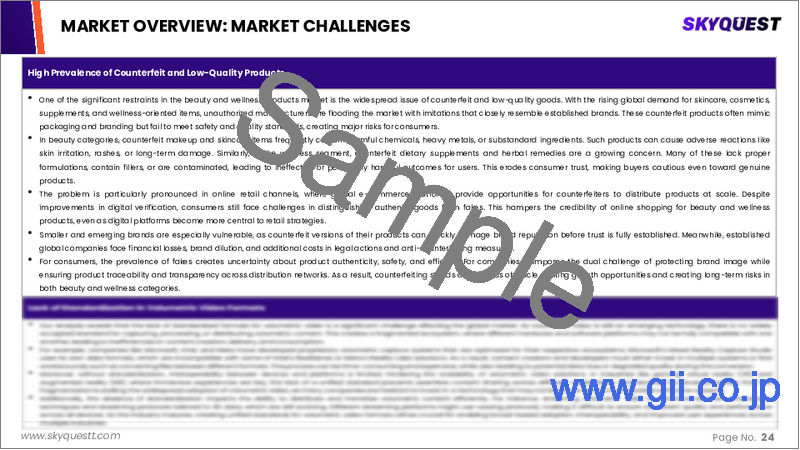|
|
市場調査レポート
商品コード
1796460
美容・ウェルネス製品市場規模、シェア、成長分析、タイプ別、流通チャネル別、エンドユーザー別、地域別-2025年~2032年産業予測Beauty and Wellness Products Market Size, Share, and Growth Analysis, By Type (Skincare, Haircare), By Distribution Channel (Online Retail, Supermarkets/Hypermarkets), By End User, By Region - Industry Forecast 2025-2032 |
||||||
|
|||||||
| 美容・ウェルネス製品市場規模、シェア、成長分析、タイプ別、流通チャネル別、エンドユーザー別、地域別-2025年~2032年産業予測 |
|
出版日: 2025年08月18日
発行: SkyQuest
ページ情報: 英文 182 Pages
納期: 3~5営業日
|
全表示
- 概要
- 目次
美容・ウェルネス製品の世界市場規模は2023年に5,572億米ドルとなり、2024年の6,001億米ドルから2032年には1兆863億1,000万米ドルに成長し、予測期間(2025年~2032年)のCAGRは7.7%で成長する見通しです。
世界の美容・ウェルネス製品市場は、主に消費者のホリスティックヘルスとセルフケアへの注目によって大きな成長を遂げています。この急成長の特徴は、美的効果とウェルネス効果の両方をもたらすナチュラル、オーガニック、クリーンな製品に対する需要の高まりです。ソーシャルメディアやウェルネス・ブロガーの影響力が消費者の嗜好を形成し続け、業界の動向を牽引しています。しかし、市場は飽和状態にあり、ブランドにとっては価格競争や運営コストの上昇につながるなどの課題に直面しています。さらにメーカーは、持続可能で環境に優しい製品に対する消費者の期待に常に適応し、成分や製品表示をめぐる規制の進化を乗り切らなければならないです。信頼を築き、「グリーンウォッシング」に対する懸念に対抗するため、ブランドは商品と実践における真の透明性を優先しなければならないです。
目次
イントロダクション
- 調査の目的
- 調査範囲
- 定義
調査手法
- 情報調達
- 二次と一次データの方法
- 市場規模予測
- 市場の前提条件と制限
エグゼクティブサマリー
- 世界市場の見通し
- 供給と需要の動向分析
- セグメント別機会分析
市場力学と見通し
- 市場概要
- 市場規模
- 市場力学
- 促進要因と機会
- 抑制要因と課題
- ポーターの分析
主な市場の考察
- 重要成功要因
- 競合の程度
- 主な投資機会
- 市場エコシステム
- 市場の魅力指数(2024年)
- PESTEL分析
- マクロ経済指標
- バリューチェーン分析
- 価格分析
- ケーススタディ
- 顧客購買行動分析
美容・ウェルネス製品市場規模:タイプ別& CAGR(2025年~2032年)
- 市場概要
- スキンケア
- 保湿剤
- クレンザー
- 美容液
- ヘアケア
- シャンプー
- コンディショナー
- 治療
- メイクアップと化粧品
- ウェルネスサプリメント
- ビタミン
- 鉱物
- パーソナルケア
- ボディウォッシュ
- デオドラント
美容・ウェルネス製品市場規模:流通チャネル別& CAGR(2025年~2032年)
- 市場概要
- オンライン小売
- スーパーマーケット/ハイパーマーケット
- 専門店
- 薬局・ドラッグストア
美容・ウェルネス製品市場規模:エンドユーザー別& CAGR(2025年~2032年)
- 市場概要
- 個人消費者
- サロン&スパ
- ホテル・ホスピタリティ
美容・ウェルネス製品市場規模& CAGR(2025年~2032年)
- 北米
- 米国
- カナダ
- 欧州
- ドイツ
- スペイン
- フランス
- 英国
- イタリア
- その他の欧州
- アジア太平洋
- 中国
- インド
- 日本
- 韓国
- その他のアジア太平洋
- ラテンアメリカ
- ブラジル
- その他のラテンアメリカ
- 中東・アフリカ
- GCC諸国
- 南アフリカ
- その他の中東・アフリカ
競合情報
- 上位5社の比較
- 主要企業の市場ポジショニング(2024年)
- 主な市場企業が採用した戦略
- 最近の市場動向
- 企業の市場シェア分析(2024年)
- 主要企業の企業プロファイル
- 企業の詳細
- 製品ポートフォリオ分析
- 企業のセグメント別シェア分析
- 収益の前年比比較(2022年~2024年)
主要企業プロファイル
- L'Oreal S.A.(France)
- The Estee Lauder Companies Inc.(United States)
- Procter & Gamble(P&G)(United States)
- Unilever PLC(United Kingdom)
- Shiseido Company, Limited(Japan)
- Beiersdorf AG(Germany)
- Johnson & Johnson(United States)
- Kao Corporation(Japan)
- Coty Inc.(United States)
- LVMH Moet Hennessy Louis Vuitton(France)
- Amorepacific Corporation(South Korea)
- Natura & Co(Brazil)
- Puig(Spain)
- Chanel(France)
- Revlon, Inc.(United States)
結論と提言
Global Beauty and Wellness Products Market size was valued at USD 557.2 billion in 2023 and is poised to grow from USD 600.1 billion in 2024 to USD 1086.31 billion by 2032, growing at a CAGR of 7.7% during the forecast period (2025-2032).
The global beauty and wellness products market is experiencing substantial growth, primarily fueled by consumers' focus on holistic health and self-care. This surge is characterized by a rising demand for natural, organic, and clean products that deliver both aesthetic and wellness benefits. The influence of social media and wellness bloggers continues to shape consumer preferences, driving trends in the industry. However, the market faces challenges, including saturation, leading to price competition and elevated operational costs for brands. Additionally, manufacturers must constantly adapt to consumer expectations for sustainable, eco-friendly products and navigate evolving regulations surrounding ingredients and product claims. To build trust and counter concerns over "greenwashing," brands must prioritize genuine transparency in their offerings and practices.
Top-down and bottom-up approaches were used to estimate and validate the size of the Global Beauty and Wellness Products market and to estimate the size of various other dependent submarkets. The research methodology used to estimate the market size includes the following details: The key players in the market were identified through secondary research, and their market shares in the respective regions were determined through primary and secondary research. This entire procedure includes the study of the annual and financial reports of the top market players and extensive interviews for key insights from industry leaders such as CEOs, VPs, directors, and marketing executives. All percentage shares split, and breakdowns were determined using secondary sources and verified through Primary sources. All possible parameters that affect the markets covered in this research study have been accounted for, viewed in extensive detail, verified through primary research, and analyzed to get the final quantitative and qualitative data.
Global Beauty and Wellness Products Market Segments Analysis
Global Beauty and Wellness Products Market is segmented by Type, Distribution Channel, End User and region. Based on Type, the market is segmented into Skincare, Haircare, Makeup & Cosmetics, Wellness Supplements and Personal Care. Based on Distribution Channel, the market is segmented into Online Retail, Supermarkets/Hypermarkets, Specialty Stores and Pharmacies & Drugstores. Based on End User, the market is segmented into Individual Consumers, Salons & Spas and Hotels & Hospitality. Based on region, the market is segmented into North America, Europe, Asia Pacific, Latin America and Middle East & Africa.
Driver of the Global Beauty and Wellness Products Market
The modern perception of beauty increasingly intertwines with the concept of overall wellness. Consumers are now seeking products that not only enhance their appearance but also contribute to their mental and physical well-being. This shift in priorities fuels the demand for items that emphasize natural ingredients, offer therapeutic benefits, and align with self-care practices. As individuals become more aware of the holistic nature of beauty, their purchasing choices increasingly reflect a desire for products that support both aesthetic improvement and a healthier lifestyle, driving growth within the beauty and wellness products market.
Restraints in the Global Beauty and Wellness Products Market
The global beauty and wellness products market faces significant challenges due to its highly competitive nature, characterized by a vast array of brands ranging from established multinational corporations to emerging indie startups. This competitive landscape necessitates substantial marketing investments, intensifying pricing pressures and driving ongoing innovation efforts aimed at capturing and retaining consumer interest. As a result, new entrants often find it difficult to differentiate themselves and gain market traction amidst the fierce rivalry present, creating barriers to success for those looking to establish a foothold in this vibrant yet challenging industry.
Market Trends of the Global Beauty and Wellness Products Market
The global beauty and wellness products market is increasingly influenced by the "clean beauty" movement, which emphasizes the demand for products free from controversial chemicals and harmful additives. Consumers are now more discerning, seeking transparency in ingredient lists and wishing to understand the sourcing and production methods behind their favorite brands. This heightened awareness compels companies to not only reformulate their offerings to align with these ideals but also to adopt greater accountability in their marketing strategies. As a result, brands that prioritize clean, sustainable practices and foster open communication with consumers are likely to gain a competitive edge in this evolving marketplace.
Table of Contents
Introduction
- Objectives of the Study
- Scope of the Report
- Definitions
Research Methodology
- Information Procurement
- Secondary & Primary Data Methods
- Market Size Estimation
- Market Assumptions & Limitations
Executive Summary
- Global Market Outlook
- Supply & Demand Trend Analysis
- Segmental Opportunity Analysis
Market Dynamics & Outlook
- Market Overview
- Market Size
- Market Dynamics
- Drivers & Opportunities
- Restraints & Challenges
- Porters Analysis
- Competitive rivalry
- Threat of substitute
- Bargaining power of buyers
- Threat of new entrants
- Bargaining power of suppliers
Key Market Insights
- Key Success Factors
- Degree of Competition
- Top Investment Pockets
- Market Ecosystem
- Market Attractiveness Index, 2024
- PESTEL Analysis
- Macro-Economic Indicators
- Value Chain Analysis
- Pricing Analysis
- Case Studies
- Customer Buying Behavior Analysis
Global Beauty and Wellness Products Market Size by Type & CAGR (2025-2032)
- Market Overview
- Skincare
- Moisturizers
- Cleansers
- Serums
- Haircare
- Shampoos
- Conditioners
- Treatments
- Makeup & Cosmetics
- Wellness Supplements
- Vitamins
- Minerals
- Personal Care
- Body Wash
- Deodorants
Global Beauty and Wellness Products Market Size by Distribution Channel & CAGR (2025-2032)
- Market Overview
- Online Retail
- Supermarkets/Hypermarkets
- Specialty Stores
- Pharmacies & Drugstores
Global Beauty and Wellness Products Market Size by End User & CAGR (2025-2032)
- Market Overview
- Individual Consumers
- Salons & Spas
- Hotels & Hospitality
Global Beauty and Wellness Products Market Size & CAGR (2025-2032)
- North America (Type, Distribution Channel, End User)
- US
- Canada
- Europe (Type, Distribution Channel, End User)
- Germany
- Spain
- France
- UK
- Italy
- Rest of Europe
- Asia Pacific (Type, Distribution Channel, End User)
- China
- India
- Japan
- South Korea
- Rest of Asia-Pacific
- Latin America (Type, Distribution Channel, End User)
- Brazil
- Rest of Latin America
- Middle East & Africa (Type, Distribution Channel, End User)
- GCC Countries
- South Africa
- Rest of Middle East & Africa
Competitive Intelligence
- Top 5 Player Comparison
- Market Positioning of Key Players, 2024
- Strategies Adopted by Key Market Players
- Recent Developments in the Market
- Company Market Share Analysis, 2024
- Company Profiles of All Key Players
- Company Details
- Product Portfolio Analysis
- Company's Segmental Share Analysis
- Revenue Y-O-Y Comparison (2022-2024)
Key Company Profiles
- L'Oreal S.A. (France)
- Company Overview
- Business Segment Overview
- Financial Updates
- Key Developments
- The Estee Lauder Companies Inc. (United States)
- Company Overview
- Business Segment Overview
- Financial Updates
- Key Developments
- Procter & Gamble (P&G) (United States)
- Company Overview
- Business Segment Overview
- Financial Updates
- Key Developments
- Unilever PLC (United Kingdom)
- Company Overview
- Business Segment Overview
- Financial Updates
- Key Developments
- Shiseido Company, Limited (Japan)
- Company Overview
- Business Segment Overview
- Financial Updates
- Key Developments
- Beiersdorf AG (Germany)
- Company Overview
- Business Segment Overview
- Financial Updates
- Key Developments
- Johnson & Johnson (United States)
- Company Overview
- Business Segment Overview
- Financial Updates
- Key Developments
- Kao Corporation (Japan)
- Company Overview
- Business Segment Overview
- Financial Updates
- Key Developments
- Coty Inc. (United States)
- Company Overview
- Business Segment Overview
- Financial Updates
- Key Developments
- LVMH Moet Hennessy Louis Vuitton (France)
- Company Overview
- Business Segment Overview
- Financial Updates
- Key Developments
- Amorepacific Corporation (South Korea)
- Company Overview
- Business Segment Overview
- Financial Updates
- Key Developments
- Natura & Co (Brazil)
- Company Overview
- Business Segment Overview
- Financial Updates
- Key Developments
- Puig (Spain)
- Company Overview
- Business Segment Overview
- Financial Updates
- Key Developments
- Chanel (France)
- Company Overview
- Business Segment Overview
- Financial Updates
- Key Developments
- Revlon, Inc. (United States)
- Company Overview
- Business Segment Overview
- Financial Updates
- Key Developments






